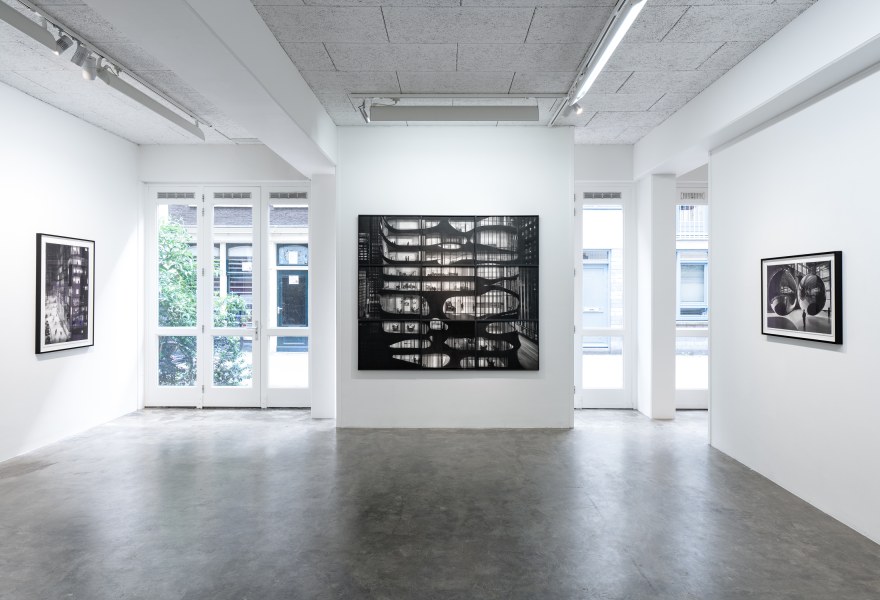16 june 2025, Flor Linckens
Radenko Milak: reflections in a shared space
At Brandt Gallery in Amsterdam, you can currently see a solo show by Bosnian artist Radenko Milak (until 5 July). Milak is known for his black-and-white watercolours, oil paintings, drawings and animated films. While much of his work has focused on major geopolitical events, the artist now presents a new series of watercolours, depicting people in and around the buildings we inhabit and the public spaces we share. We see figures caught in reflection, between glass and sky, in scenes that suggest more than they reveal. Milak seeks, above all, to capture a specific mood. At times, the location is mentioned in the title, at other moments the image remains more elusive. The works were partly created during a residency at the DC Foundation in Miami.
The exhibition highlights Milak’s recent exploration of the spherical form, a symbol of infinity, reflection and technological advancement. In some works, figures gaze at themselves in mirrored surfaces, suspended in moments of introspection. This fascination with technology is closely tied to his broader interest in how images act as carriers of collective memory, political power and cultural transformation. While much of Milak’s earlier work was based on found imagery, this exhibition marks a shift towards a more inward-looking approach.
Because many of Milak’s detailed and often monochromatic works are based on images drawn from newspapers, postcards, documentary photography, old films, propaganda archives and the internet. He works from the conviction that our perception of the world and its history is largely shaped by the relentless flow of images through which we record and interpret what we call reality. The mass media continue to shape our collective memory with images that circulate endlessly and shift in meaning over time. They reveal how we view the world, both then and now. Milak’s approach is both analytical and intuitive. He searches for moments in which history reveals itself in small ways: a gesture, a shadow, a detail easily lost in the pace of the news cycle. He does not necessarily depict the events themselves, but their aftermath, their impact, their echo. In doing so, he connects global political themes to individual vulnerability and to the slowness of memory in an age of fleeting images.
Milak: “For me, the role, the nature of the image today is crucial, especially in the era of digital revolution, also I am very interested to understand the status of image today as a political fact. To use them and to construct them as new versions of stories. This relationship has become even more important with the expansion of social networks and new information technologies. I’ve placed at the heart of my activity as a painter the question of what a painting could be at the age of the digital time and continuous accessibility to images.”
History, memory, imagination and the influence of modern technology are recurring themes throughout the artist’s practice. In earlier works, he drew inspiration from post-war trauma, historic disasters, climate issues and the visual documentation of political conflict.
Milak’s method is slow, meticulous and layered: he translates imagery into black pigment on white paper. These are not reproductions but reinterpretations. By shifting the photograph from its original context into paint, he interrupts the flow of image consumption and opens up space for doubt, reflection and re-reading. The result is a series of enigmatic images that nonetheless feel strangely familiar. From a distance, Milak’s black-and-white works appear photographic, but a closer look reveals the unmistakable hand of the painter. In doing so, he plays with the tension between the objective and the subjective, questioning the widely held belief that photography captures reality — a notion long since dismantled.
Radenko Milak was born in 1980 in what is now Bosnia and Herzegovina. He studied at the Academy of Fine Arts in Banja Luka and at the University of Fine Arts in Belgrade. His work has been exhibited at Museum Darmstadt, the Museum of Contemporary Art in Belgrade, Deichtorhallen Hamburg and the Museum of Contemporary Art in Zagreb. In 2017, he represented Bosnia and Herzegovina at the Venice Biennale, alongside Roman Uranjek and several guest artists. His work has been acquired by major public collections including the Folkwang Museum in Essen, the Albertina Museum in Vienna, the Kunstmuseum in Wolfsburg, the Jewish Museum in Frankfurt and the Hessisches Landesmuseum in Darmstadt, as well as agnès b. and Art Collection Telekom.



